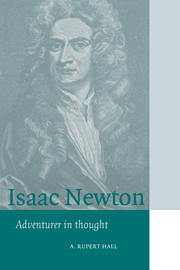Book contents
- Frontmatter
- Contents
- List of Figures
- General Editor's Preface
- Foreword
- Acknowledgement
- 1 The Hopeful Youth, 1642–1664
- 2 “The prime of my age for invention”, 1664–1667
- 3 Widening Horizons, 1667–1669
- 4 The Professor of Mathematics, 1669–1673
- 5 Publication and Polemic, 1672–1678
- 6 Life in Cambridge, 1675–1685
- 7 The Chemical Philosopher, 1669–1695
- 8 The Mathematical Principles of Natural Philosophy, 1679–1687
- 9 Private and Public life, 1685–1696
- 10 Fluxions and Fury, 1677–1712
- 11 Opticks, or a Treatise of Light, 1687–1704
- 12 Life in London, 1696–1718
- 13 A Man of Authority and Learning, 1692–1727
- 14 Later Books, 1706–1726
- 15 Kensington, 1725–1727
- Appendices
- A Newton's Alchemical Studies and his Idea of the Atomic Structure of Matter
- B Newton's Portraits
- C Newton's London Homes
- D Jonathan Swift and Catherine Barton
- E The Fate of Newton's Papers and his Library
- Notes
- Bibliography
- Index
C - Newton's London Homes
Published online by Cambridge University Press: 12 January 2010
- Frontmatter
- Contents
- List of Figures
- General Editor's Preface
- Foreword
- Acknowledgement
- 1 The Hopeful Youth, 1642–1664
- 2 “The prime of my age for invention”, 1664–1667
- 3 Widening Horizons, 1667–1669
- 4 The Professor of Mathematics, 1669–1673
- 5 Publication and Polemic, 1672–1678
- 6 Life in Cambridge, 1675–1685
- 7 The Chemical Philosopher, 1669–1695
- 8 The Mathematical Principles of Natural Philosophy, 1679–1687
- 9 Private and Public life, 1685–1696
- 10 Fluxions and Fury, 1677–1712
- 11 Opticks, or a Treatise of Light, 1687–1704
- 12 Life in London, 1696–1718
- 13 A Man of Authority and Learning, 1692–1727
- 14 Later Books, 1706–1726
- 15 Kensington, 1725–1727
- Appendices
- A Newton's Alchemical Studies and his Idea of the Atomic Structure of Matter
- B Newton's Portraits
- C Newton's London Homes
- D Jonathan Swift and Catherine Barton
- E The Fate of Newton's Papers and his Library
- Notes
- Bibliography
- Index
Summary
Newton first took up residence in a house in Jermyn Street (now number 88) towards the socially superior western end, in which he lived four years, then from 1700 to 1709 in the next-door house (87). Sir Robert Gayer was a near neighbour (letter 710). Leases for these properties had been granted by the trustees of the Earl of St Albans in 1665, and the buildings were put up about ten years later. Number 87 is at present undergoing total reconstruction and number 88 is a shop (‘James Bodenham’) with the original brick structure preserved.
After his brief sojourn in Chelsea (where he lived at the east end of Paradise Row) Newton moved to 35 St Martin's Street, a few yards south of Leicester Fields (now Square), an area just newly developed by Lord Leicester. There he lived in a house built c.1695 from 1711 to 1725. It had three storeys with basement and was built of brick with a tiled roof; there was a bracketed hood over the front door. On the main floors were rooms front and back with a projecting ‘closet’ wing at the rear. The ground-floor front room was panelled. According to a footnote in the Survey of London Newton had a small observatory built at the top of the house.
In Kensington he lived (in lodgings?) in Orbell's Buildings, a little north of Kensington High Street and west of Church Street, a site now occupied by Bullingham Mansions. He already owned property south of the High Street.
- Type
- Chapter
- Information
- Isaac NewtonAdventurer in Thought, pp. 389 - 390Publisher: Cambridge University PressPrint publication year: 1996

